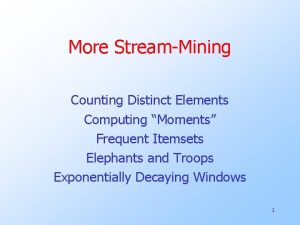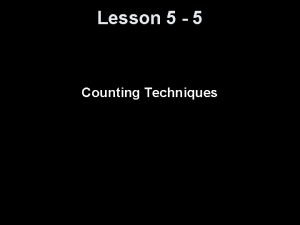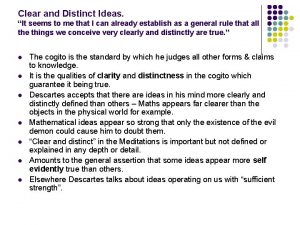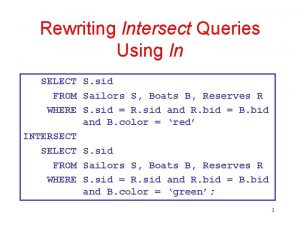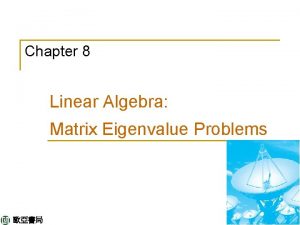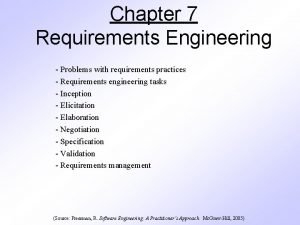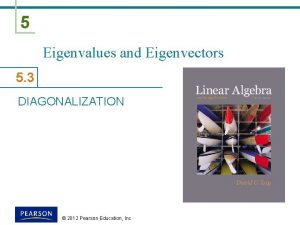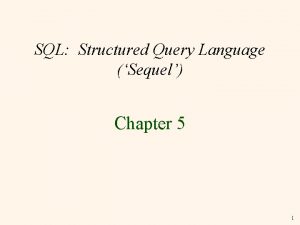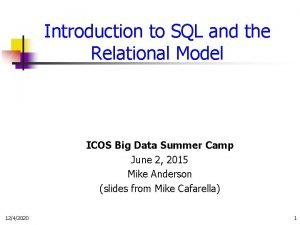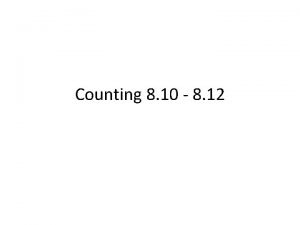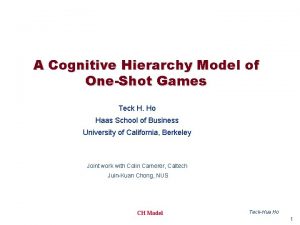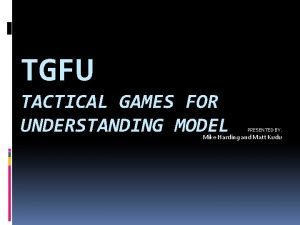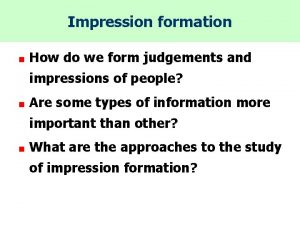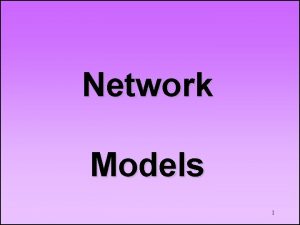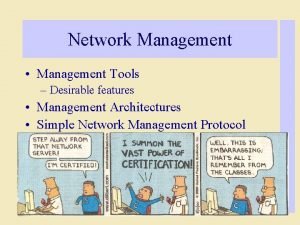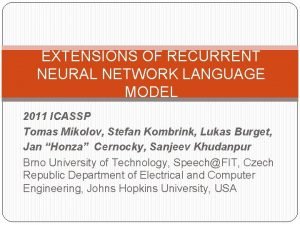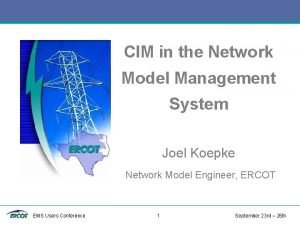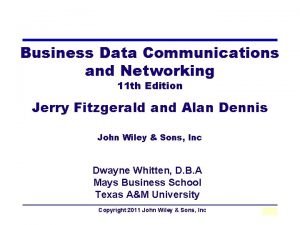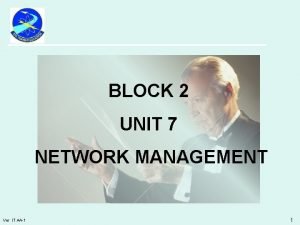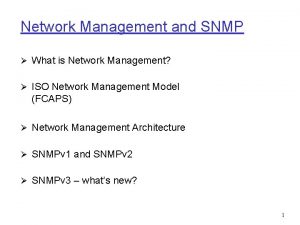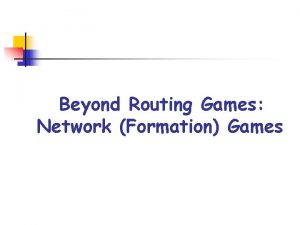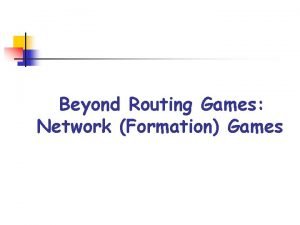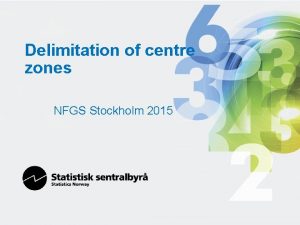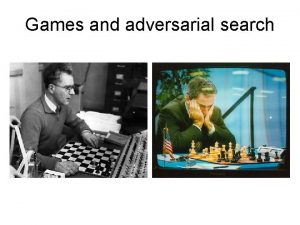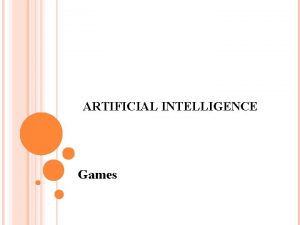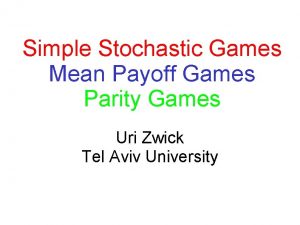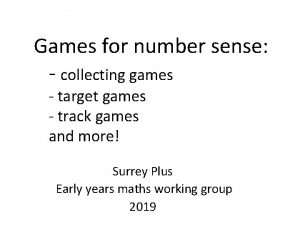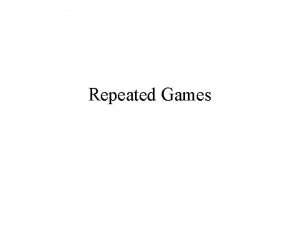Network Formation Games n n NFGs model distinct


![Articles n [1] A contract-based model for directed network formation (2005) Johari R, Mannor Articles n [1] A contract-based model for directed network formation (2005) Johari R, Mannor](https://slidetodoc.com/presentation_image_h2/627cf265c6eb90b4dc0b6a0b084e5a21/image-3.jpg)




































![Our thoughts for improvement for paper [1] n n n When congestion appears give Our thoughts for improvement for paper [1] n n n When congestion appears give](https://slidetodoc.com/presentation_image_h2/627cf265c6eb90b4dc0b6a0b084e5a21/image-40.jpg)



















![Our thoughts for improvement for paper [2] n n n Apply Bayesian inference methods Our thoughts for improvement for paper [2] n n n Apply Bayesian inference methods](https://slidetodoc.com/presentation_image_h2/627cf265c6eb90b4dc0b6a0b084e5a21/image-60.jpg)


- Slides: 62


Network Formation Games n n NFGs model distinct ways in which selfish agents might create and evaluate networks Agents aim to: n n to minimize the expenses to ensure high quality of service *Nissan, Roughgarden, Tardos, Vazirani(2007)
![Articles n 1 A contractbased model for directed network formation 2005 Johari R Mannor Articles n [1] A contract-based model for directed network formation (2005) Johari R, Mannor](https://slidetodoc.com/presentation_image_h2/627cf265c6eb90b4dc0b6a0b084e5a21/image-3.jpg)
Articles n [1] A contract-based model for directed network formation (2005) Johari R, Mannor S, Tsitsiklis J n [2] A game for Ad Hoc Network Connectivity in the presence of Malicious users (2006) Theodorakopoulos G, Baras J n [3] On a Network Creation Game (2003) Fabrikant A, Luthra A, Maneva E, Papadimitriou C, Shenker S n [4] Network Formation: Bilateral Contracting and Myopic Dynamics (2007) Arcaute E, Johari R, Mannor S

1 st Article A contract-based model for directed network formation(2005) Johari R, Mannor S, Tsitsiklis J

The model n n Multiple players (nodes) interact to form a graph with directed links Bilateral negotiation aiming to result in a contractual agreement between two nodes to form a directed link ( flow of goods from the upstream node to the downstream node).

The model n The upstream node n benefits from the improved connectivity however n the downstream node n suffers a cost due to the additional flow sent through it.

The model n The resolution to this tradeoff a contract where the upstream node compensates the downstream node.

The game n n n Players The nodes, each of whom wishes to route a given amount of traffic between themselves. Actions Node i’s set of action is the set of its possible bid s to the other nodes, to form a link and the minimum acceptance value from the other nodes. Preferences Each node wishes to send a given amount of traffic to some of the other nodes with the minimum cost

Some definitions n Given the strategies of all the nodes, denoted by the vector s = (pij , qji i, j V, j ≠ i), a directed graph G(s) = (V, A(s)) is formed, where: A(s) ={(i, j ): i ≠ j, pij ≥qij}

Some definitions The cost to node i where, n n ci the cost that is incurred in node i for each unit of traffic which either passes through or terminates at i. fi(A) is the amount of flow passing through or terminating at node I ai a cost proportional to the traffic bij that i wishes to send j that is incurred in node i, if destination j is unreachable from node I wi(A) the set of nodes j ≠I which are unreachable from node i, given the set of links A.

Some definitions The payoff to node i

Link stable equilibria n A strategy vector s is link stable equilibrium if for every possible link (i, j ) E the following conditions hold: (1) For any s’(i, j) = (p’ij , qji) : n Ri(s’(i, j), s. E{(i, j)})≤ Ri(s) (2) For any s’(i, j) = (pij , q’ji) : n Rj(s’(i, j), s. E{(i, j)})≤ R j ( s) (3) For any s’(i, j) = (p’ij , q’ji), at least one of the following holds : n n Ri(s’(i, j), s. E{(i, j)})≤ Ri(s) Rj(s’(i, j), s. E{(i, j)})≤ Rj(s)

Some thoughts n Parallel and distributed computing n Local network

Some thoughts n Parallel and distributed computing n Internet

Some thoughts n Parallel and distributed computing n Internet

2 nd Article A game for Ad Hoc Network Connectivity in the presence of Malicious users (2006) Theodorakopoulos G, Baras J

The model n n G=(V, E): undirected graph V=VGUVB , where VG , the set of good users n VB , the set of bad users Each user has a choice between cooperating (C) to activate the adjacent links, or defecting (D), which effectively kills all adjacent links. A link (i, j) is considered to be active if and only if both users i and j choose to cooperate (C). Each user chooses only one action (C or D) for all links, not one action per link. n n

The model n n The game is played repeatedly in rounds Good users n n n follow the fictitious play process. are cooperative, as long as their neighbors are cooperative. Bad users n n know everything that has ever happened in the network, and are also aware of the decision algorithm that the Good use aim to disrupt the network and waste the energy of the Good users.

Payoff matrices Bad Good C D C N-E , E-N -E , E D 0, 0 N≥E Good C D C N-E , N-E -E , 0 D 0 , -E 0, 0 N≥E

How Good users play n So, a Good player’s action is determined as follows ( = 1 for C, 0 for D): *( the estimated probability that player j will play C in round t+1)

How Bad users play Bad Good C D C N-E , E-N -E , E D 0, 0 N≥E §D is a weakly dominating action for the Bad §Is “Always D” the definite strategy for the Bad ?

An example

An example

An example Is the “Keep the Good at C” strategy always better than “Always D” for every topology?

A second example

A second example

Work for the future Is there an exact connection between the topology and the optimal strategy that the Bad users can play against the simple fictitious play of the Good ones? Not found yet!!

3 rd Article On a Network Creation Game (2003) Fabrikant A, Luthra A, Maneva E, Papadimitriou C, Shenker S

The model n n Strategy for player i is the set of undirected edges that i will build The constructed network will be G(S), where S is the strategy space

Utility function The cost incurred by a player i is defined n l l l α is the cost of each edge d(i, j) is the distance between nodes i and j ni is the number of edges bought by node i

Example

Solution n n Nash equilibrium theory is used as the solution concept Starting from one strategy combination, replace (repeatedly) a player’s strategy by its best response The final resulting graph should be stable The overall quality of network is evaluated by Social Cost

Social Cost To evaluate the overall quality of the network consider social cost l l l In social cost each term d. G(i, j) contributes to the overall quality twice In a stable network each edge (i, j) is bough at most by one player Because the distance d. G(i, j) is infinite whenever i and j are not connected, any stable network must be connected

Equilibria n n n For α<1 the complete graph is the only N. E. For 1≤ α<2, the complete graph is a social optimum (it is no longer a N. E) For a≥ 2 then star is a N. E.

Upper – Lower Bound Upper Bound For α<n 2 the price of anarchy is Lower Bound For any ε>0, there exists a N. E. with price of anarchy greater than 3 -ε

Tree conjecture n n There exists a constant A, such that for all α>A, all non-transient Nash equilibria are trees It has been disproved by [*] On Nash equilibria for a network creation game. Albers et al (2006)

Transient Nash Equilibrium Weak Nash Equilibrium At least one player can change its strategy without affecting its cost Transient N. E. It is weak equilibrium from which there exists a sequence of single-player strategy changes, which do not alter the changer’s payoff leading eventually to a non-equilibrium position

Article n n They showed that for any positive integer n 0, there exists a graph built by n≥ n 0 players that contain cycles and forms a strong N. E. Also, they proved that if α≥ 12 nlogn then every N. E. is a tree

Problems n n n Stars are efficient for Internet but are problematic due to congestion Internet is not strictly a star or a connected graph Usually the networks are dynamical (time)
![Our thoughts for improvement for paper 1 n n n When congestion appears give Our thoughts for improvement for paper [1] n n n When congestion appears give](https://slidetodoc.com/presentation_image_h2/627cf265c6eb90b4dc0b6a0b084e5a21/image-40.jpg)
Our thoughts for improvement for paper [1] n n n When congestion appears give penalty to user Introduce time using stochastic process If a user bought many links make better pricing, so that cost α not to be stable for each link

Similarities – Differences between two articles SIMILARITIES n Application on topology formation in ad hoc networks n They belong to Local Connection Games n They construct an undirected graph DIFFERENCES [1] consider Nash equilibria [2] consider pairwise stability between nodes

4 th Article Network Formation: Bilateral Contracting and Myopic Dynamics (2007) Arcaute E, Johari R, Mannor S

Applications n n Mobile ad-hoc Networks The internet at the ISP level

What bad with N. E. n n n The set of equilibria can be quite large Equilibria is not always efficient Depending on the model formulation, N. E. may fail to exist

The model n n The players (strategic agents) interact to choose their connections. Particularly, there is a bilateral contracting Nodes are only aware of local interactions and can only be connected through local connections Links is the result of bilateral contract between their endpoints (also, edges are undirected) There is a dynamic process of network formation

Terminology n n n The outcome arising from strategic decisions of the nodes is posed with triplet (G, Γ, P) Where P is the Payment Matrix which keeps track of payments Γ is an directed graph which keeps tracks of contracts

Dynamics n n n Dynamics are designed so that each stage consists of a unilateral deviation followed by a bilateral deviation This two-stage dynamics (but, one-time step in the dynamics) fits the solution concept of pairwise stability Dynamics describe the myopic behavior of a strategic agent

Pairwise Stability A network is pairwise stable if no coalition of at most 2 nodes can profitably deviate Specifically, n Pairwise stability requires that no unilateral deviations by a single node are profitable, and that no bilateral deviations by any pair of nodes are profitable n

Myopic behavior n n Strategic agents only myopically react to the last play of their competitors They never look ahead in determining their best action

Example

Application - Traffic routing in networks Nodes incur a cost which consists of 1) Routing cost, 2) Link maintenance cost, 3) Disconnection cost,

Routing Cost n n ci≥ 0 is the routing cost per unit of traffic fi(G) is the total traffic that transits through plus the total traffic received by

Link maintenance cost n n di(G) is the degree of node i in the graph G π>0 is the maintenance cost that is incurred by the endpoints of each link

Disconnection cost n n is the number of nodes ni(G) is the number of nodes I can reach λ>0 is the cost per unit of traffic not sent because the network is not connected

Convergence n Given any initial outcome, the dynamics converge if there exists K such that, for k>K (k is a round)

Theorem n n For any activation process, the dynamics initiated at any outcome converge. Further, if the activation process is a uniform activation process, then the expected number of rounds to convergence is O(n 5)

Theorem (continuing) n Given an activation sequence, the limiting state is such that: 1. 2. The network topology is a tree It is a pairwise stable outcome

Activation process. Activation sequence Activation process Any discrete-time stochastic process {(uk, vk)} where the pairs (uk, vk) are i. i. d. random pairs of distinct nodes Activation sequence A realization of an activation process

Limitations n n Parameter λ (disconnection cost) is identical for all nodes Parameter π (formation cost) is identical for all links Nodes are required to have global information about the network (which is not realistic in most modern data-networks) Dynamics are in a very restricted version (first stage 1 then stage 2)
![Our thoughts for improvement for paper 2 n n n Apply Bayesian inference methods Our thoughts for improvement for paper [2] n n n Apply Bayesian inference methods](https://slidetodoc.com/presentation_image_h2/627cf265c6eb90b4dc0b6a0b084e5a21/image-60.jpg)
Our thoughts for improvement for paper [2] n n n Apply Bayesian inference methods for evaluation of λ and π Use Unilateral decisions which are more flexible Allow the elimination of one stage, e. g. stage 1, for flexibility

Thank you for your attention!!!

Questions ?
 Network formation games
Network formation games Chapter 23 hunger games questions
Chapter 23 hunger games questions Types of games indoor and outdoor
Types of games indoor and outdoor Formation initiale vs formation continue
Formation initiale vs formation continue Serious games network
Serious games network Unordered
Unordered Counting distinct elements in a stream in big data
Counting distinct elements in a stream in big data Distinct permutations
Distinct permutations Clear and distinct ideas
Clear and distinct ideas If a purely competitive firm shuts down in the short run
If a purely competitive firm shuts down in the short run The four distinct eras of a pharmacist are
The four distinct eras of a pharmacist are English paragraph
English paragraph Select distinct r.sid
Select distinct r.sid West asian israel arabia musical instruments
West asian israel arabia musical instruments Distinct planes
Distinct planes Distinct eigenvalues
Distinct eigenvalues Unitary matrix
Unitary matrix Inception in requirement engineering
Inception in requirement engineering Most distinct feature of
Most distinct feature of Distinct eigenvalues
Distinct eigenvalues Select distinct r.sid
Select distinct r.sid Select distinct sql
Select distinct sql Select distinct sql
Select distinct sql Option distinct genexus
Option distinct genexus Distinct proper subsets
Distinct proper subsets Identical objects into distinct bins
Identical objects into distinct bins Visual elements - light and color
Visual elements - light and color Plantae method of nutrition
Plantae method of nutrition Select * from where
Select * from where Xquery basics
Xquery basics Nhibernate sql injection
Nhibernate sql injection Consolewrite
Consolewrite A business created as a distinct legal entity
A business created as a distinct legal entity Distinct nystagmus at maximum deviation
Distinct nystagmus at maximum deviation Distinct threadlike structures contain genetic
Distinct threadlike structures contain genetic What makes up each of jupiter's three distinct layers
What makes up each of jupiter's three distinct layers Due process can be divided into two distinct categories
Due process can be divided into two distinct categories Cognitive hierarchy
Cognitive hierarchy Role model games
Role model games Contoh model instructional games
Contoh model instructional games Tactical games model
Tactical games model Difference between virtual circuit and datagram
Difference between virtual circuit and datagram Network topologies
Network topologies Features of peer to peer network and client server network
Features of peer to peer network and client server network Network systems design using network processors
Network systems design using network processors Network centric computing and network centric content
Network centric computing and network centric content Difference between circuit message and packet switching
Difference between circuit message and packet switching Configural model of impression formation
Configural model of impression formation A model of destination image formation
A model of destination image formation Schein three levels of culture examples
Schein three levels of culture examples Steps in digital image processing
Steps in digital image processing Difference between concentric zone model and sector model
Difference between concentric zone model and sector model Snmp model in computer networks
Snmp model in computer networks Osi network management model
Osi network management model Network model linear programming
Network model linear programming Numara network monitor
Numara network monitor Osi network management model
Osi network management model Network management and administration
Network management and administration Extensions of recurrent neural network language model
Extensions of recurrent neural network language model Network model management
Network model management 5 layer network model
5 layer network model Imon internet outage
Imon internet outage Iso network management
Iso network management






